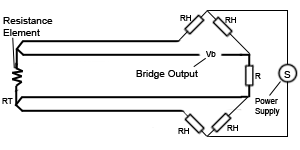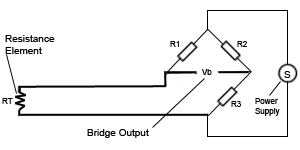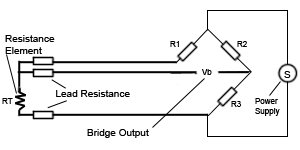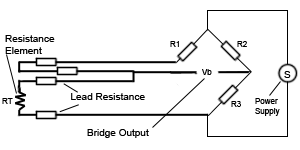Resistance thermometer
Resistance thermometers, also called resistance temperature detectors (RTDs), are temperature sensors that exploit the predictable change in electrical resistance of some materials with changing temperature. As they are almost invariably made of platinum, they are often called platinum resistance thermometers (PRTs). They are slowly replacing the use of thermocouples in many industrial applications below 600 °C.
General description
There are two broad categories, "film" and "wire-wound" types.
- Film thermometers have a layer of platinum on a substrate; the layer may be extremely thin, perhaps 1 micrometer. Advantages of this type are relatively low cost and fast response. Such devices have improved in performance although the different expansion rates of the substrate and platinum give "strain gauge" effects and stability problems.
- Wire-wound thermometers can have greater accuracy, especially for wide temperature ranges. The coil diameter provides a compromise between mechanical stability and allowing expansion of the wire to minimize strain and consequential drift.
The current international standard which specifies tolerance and the temperature to electrical resistance relationship for platinum resistance thermometers is IEC 751:1983. By far the most common devices used in industry have a nominal resistance of 100 ohms at 0 °C, and are called Pt-100 sensors ('Pt' is the symbol for platinum). The sensitivity of a standard 100 ohm sensor is a nominal 0.385 ohm/°C. RTDs with a sensitivity of 0.375 and 0.392 ohm/°C are also available.
How do resistance thermometers work?
Resistance thermometers are constructed in a number of forms and offer greater stability, accuracy and repeatability in some cases than thermocouples. While thermocouples use the Seebeck effect to generate a voltage, resistance thermometers use electrical resistance and require a small power source to operate. The resistance ideally varies linearly with temperature.
Resistance thermocouples are usually made using platinum, because of its linear resistance-temperature relationship and its chemical inertness. The platinum detecting wire needs to be kept free of contamination to remain stable. A platinum wire or film is supported on a former in such a way that it gets minimal differential expansion or other strains from its former, yet is reasonably resistant to vibration.
Commercial platinum grades are produced which exhibit a change of resistance of 0.385 ohms/°C (European Fundamental Interval) The sensor is usually made to have a resistance of 100 Ω at 0 °C. This is defined in BS EN 60751:1996. The American Fundamental Interval is 0.392 Ω/°C.
Resistance thermometers require a small current to be passed through in order to determine the resistance. This can cause self-heating, and manufacturers' limits should always be followed along with heat path considerations in design. Care should also be taken to avoid any strains on the resistance thermometer in its application. Lead wire resistance should be considered, and adopting three and four wire connections can eliminate connection lead resistance effects from measurements.
Advantages and limitations
Advantages of platinum resistance thermometers:
- High accuracy
- Low drift
- Wide operating range
- Suitability for precision applications
Limitations:
- RTDs in industrial applications are rarely used above 660 °C. At temperatures above 450 °C it becomes increasingly difficult to prevent the platinum from becoming contaminated by impurities from the metal sheath of the thermometer. This is why laboratory standard thermometers replace the metal sheath with a glass construction.
- Compared to thermistors, platinum RTDs are less sensitive to small temperature changes and have a slower response time. However, thermistors have a smaller temperature range.
Resistance thermometer elements
Resistance thermometers elements are available in a number of forms. The most common are:
- Wire-wound in a ceramic insulator - works with temperatures to 850 °C
- Wires encapsulated in glass - resists vibration, offers the most protection to the detecting wire, and is inexpensive to mass-produce.
Resistance thermometer construction
 These elements nearly always require insulated leads attached. At low temperatures PVC, silicon rubber or PTFE insulators are common to 250 °C. Above this, glass fibre or ceramic are used. The measuring point and usually most of the leads require a housing or protection sleeve. This is often a metal alloy which is inert to a particular process. Often more consideration goes in to selecting and designing protection sheaths than sensors as this is the layer that must withstand chemical or physical attack and offer convenient process attachment points.
These elements nearly always require insulated leads attached. At low temperatures PVC, silicon rubber or PTFE insulators are common to 250 °C. Above this, glass fibre or ceramic are used. The measuring point and usually most of the leads require a housing or protection sleeve. This is often a metal alloy which is inert to a particular process. Often more consideration goes in to selecting and designing protection sheaths than sensors as this is the layer that must withstand chemical or physical attack and offer convenient process attachment points.
Resistance thermometer wiring configurations
Two-wire configuration
The simplest resistance thermometer configuration uses two wires. It is only used when high accuracy is not required as the resistance of the connecting wires is always included with that of the sensor leading to errors in the signal. Using this configuration you will be able to use 100 metres of cable. This applies equally to balanced bridge and fixed bridge systems. The values of the lead resistance can only be determined in a separate measurement without the resistance thermometer sensor and therefore a continuous correction during the temperature measurement is not possible.
Three-wire configuration
In order to minimize the effects of the lead resistances a three wire configuration can be used. Using this method the two leads to the sensor are on adjoining arms, there is a lead resistance in each arm of the bridge and therefore the lead resistance is cancelled out. High quality connection cables should be used for this type of configuration because an assumption is made that the two lead resistances are the same. This configuration allows for up to 600 metres of cable.
Four-wire configuration
The four wire resistance thermometer configuration even further increases the accuracy and reliability of the resistance being measured. In the diagram above a standard two terminal RTD is used with another pair of wires to form an additional loop that cancels out the lead resistance. The above Wheatstone bridge method uses a little more copper wire and is not a perfect solution. Below is a better alternative configuration that should be used in all RTD's. It provides full cancellation of spurious effects and cable resistance of up to 15 Ω can be handled.
pf 600 mm cable in the circuits

History
The application of the tendency of electrical conductors to increase their electrical resistance with rising temperature was first described by Sir William Siemens at the Bakerian Lecture of 1871 before the Royal Society of Great Britain. The necessary methods of construction were established by Callendar, Griffiths, Holborn and Wein between 1885 and 1900. is being confirmed the theory
Standard resistance thermometer data
Temperature sensors are usually supplied with thin-film elements. These are rated as:
| Tolerance Class | Valid Range |
|---|---|
| Tolerance class B | -70 to +500 °C |
| Tolerance class A (1/2B) | -30 to +350 °C |
| Tolerance class 1/3B | 0 to +100 °C |
Resistance thermometer elements can be supplied which function up to 850 °C. Sensor tolerances are calculated as:
| Tolerance Class | Temperature Deviation |
|---|---|
| Class B | t = ±(0.3+0.005|t|) |
| Class A | t = ±(0.15+0.0025|t|) |
| 1/3 DIN | t = ±1⁄3 × (0.3+0.005|t|) |
| 1/5 DIN | t = ±1⁄5 × (0.3+0.005|t|) |
| 1/10 DIN | t = ±1⁄10 × (0.3+0.005|t|) |
where |t| = absolute value of temperature in °C. Where elements have a resistance of n x 100 Ω then the basic values and tolerances also have to be multiplied by n.
Temperature to resistance equation
The relation between temperature and resistance is given by the Callendar-Van Dusen equation,
Here, is the resistance at temperature T, is the resistance at 0 °C, and the constants (for a platinum RTD) are
Since the B and C coefficients are relatively small, the resistance changes almost linearly with the temperature.
References
Text and images used by permission of Peak Sensors Ltd:
Resistance Thermometer Information
See also
External links
- RTD resistance calculator
- Platinum RTDs (PDF) from Honeywell Sensing and Control
- http://www.heatonc.com/rtd1.php RTD Specifications




![{\displaystyle R_{T}=R_{0}\left[1+AT+BT^{2}+cT^{3}(T-100)\right]\;(-200\;{}^{\circ }\mathrm {C} <T<0\;{}^{\circ }\mathrm {C} ,}](/media/api/rest_v1/media/math/render/svg/0452c293ee5fbc18e59dad67c9343b9a7891ced8)
![{\displaystyle R_{T}=R_{0}\left[1+AT+BT^{2}\right]\;(0\;{}^{\circ }\mathrm {C} \leq T<850\;{}^{\circ }\mathrm {C} ).}](/media/api/rest_v1/media/math/render/svg/c2dee8f5b1c906719f57def2cb23185fcb50620e)




